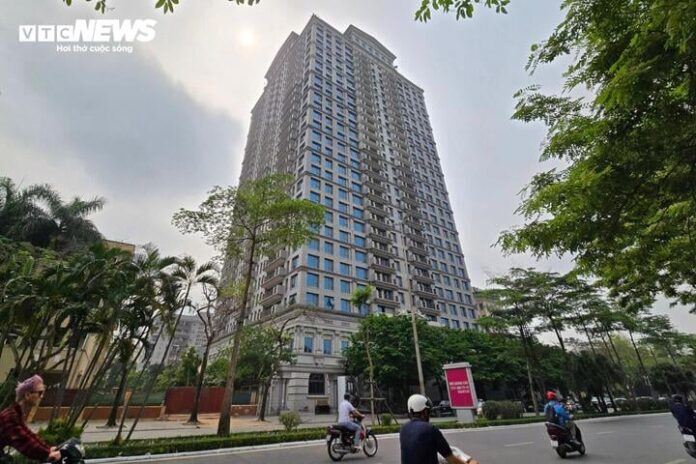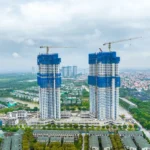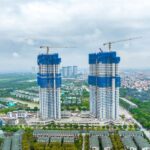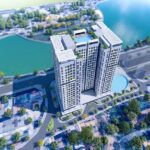Over a month ago, Ms. Nguyen Thi Nhan from Nam Dinh was shown an apartment in Tay Ho district, Hanoi, by a real estate agent. What shocked her was that the price of this apartment was on par with the prices of many landed properties in the city.
This apartment in Tay Ho district is priced at an astonishing 260 million VND per square meter. The unit that Ms. Nhan viewed measures 90 square meters, amounting to 23.5 billion VND.
“I was flabbergasted when I heard the price of this apartment. While I knew that property prices are high, I never imagined they could reach this level,” shared Ms. Nhan.
Similarly, Mr. Le Anh Dung from Lang Son was taken to view an apartment in Ba Dinh district just over a week ago. The 95-square-meter apartment is located in an alleyway just 5 meters wide, yet it is priced at 250 million VND per square meter, totaling nearly 24 billion VND.

Apartment prices in central Hanoi are comparable to landed properties. (Illustrative image: Minh Duc)
“I was taken aback by the price quoted by the agent for this apartment located in an alley. Despite being in the city center, such a high price is unreasonable,” expressed Mr. Dung.
Mr. Dung believes that the price of nearly 250 million VND per square meter is comparable to that of many landed properties in several districts and counties in Hanoi.
According to Mr. Dung, despite predictions of saturation, apartment prices in certain areas of Ba Dinh district continue to set new records, increasing by 7-25% compared to over a year ago. A luxury apartment project in Hoan Kiem district is advertised at a staggering 500-700 million VND per square meter, totaling approximately 50-120 billion VND per unit.
“You would need at least 30 billion VND to consider potential apartments in the city center these days,” Mr. Dung shared.
A recent report by the Vietnam Real Estate Brokers Association (VARS) also indicates that apartment prices in many areas are on par with landed properties.
VARS cited examples from Tay Ho district, where apartments are priced between 150 and 270 million VND per square meter. In Ba Dinh district, some sky villas are offered at around 250-260 million VND per square meter, while regular units are still in the range of 140-200 million VND per square meter. Notably, in Hoan Kiem district, a luxury apartment project is priced at 500-700 million VND per square meter. Even in Dong Anh district, apartment prices have reached 110 million VND per square meter.
With these prices, apartments are approaching or even surpassing the prices of landed properties in many projects in other areas of Hanoi.
In reality, Hanoi is witnessing an increasing number of apartments with prices comparable to landed properties. For instance, a project comprising five towers along Vo Chi Cong street in Tay Ho district is offering booking slots with rumored prices of 6,800-10,700 USD per square meter, equivalent to 170-268 million VND, excluding VAT. The initial units have areas ranging from 76 to 284 square meters, corresponding to 1 to 4 bedrooms.
Is it worth investing in these ultra-expensive apartments?
According to experts, one of the main reasons for the surge in apartment prices is the increasing input costs, including land prices, materials, legal fees, and financial expenses. Additionally, the limited supply of affordable housing and social housing leaves residents with fewer options.
Mr. Nguyen Van Dinh, Chairman of the Vietnam Real Estate Brokers Association, points out that the new Laws on Real Estate Business and Housing have created a new legal framework, eliminating weaker developers in terms of financial capacity. The remaining developers are obliged to develop large-scale urban areas with comprehensive infrastructure and amenities, resulting in higher costs and making it challenging for housing prices to decrease.

Caution is advised when investing in ultra-luxury apartments. (Illustrative image: Cong Hieu)
Simultaneously, with only financially robust developers remaining in the market, the phenomenon of supply monopoly will persist. These large developers will continue to set market prices, tending towards higher levels to maximize profits.
This situation underscores the urgent need to enhance state management efficiency in the real estate market.
Offering advice to investors, Mr. Dinh mentions that over 58% of new supply in the market belongs to the high-end and luxury segments, while affordable housing is almost non-existent.
The upward trend in Hanoi’s apartment prices is mainly driven by newly launched projects with exorbitant price tags. In contrast, some projects have maintained their selling prices after a period of rapid increases.
Despite the high prices, Mr. Dinh notes that high-end apartments have low liquidity as they cater to a limited group of high-income individuals.
“The surge in high-end apartment prices in Hanoi, reaching levels comparable to villas and landed properties, reflects the significant shifts in the real estate market. However, without proper regulation and balance across segments, the risks of a price bubble and market imbalance are inevitable in the near future,” warns Mr. Dinh.
Sharing the same viewpoint, Mr. Le Dinh Chung, CEO of SGO Homes, states that projects with “super-expensive” prices are usually located in prime central areas, and developers target a specific group of affluent buyers rather than the general public.
Consequently, the liquidity of products priced above 150 million VND per square meter is low, if not stagnant. Surveys by market research units also indicate that apartments, especially those in older projects, are facing significant sales challenges due to excessive price increases. Therefore, investors should exercise caution.
“The Rising Cost of Real Estate: Unraveling the Mystery”
The Government requires an urgent review to identify the factors contributing to the rise in real estate prices, including land prices, material costs, and interest rates. It is imperative to devise strategies to mitigate these price-driving factors, enhance accessibility, and boost supply to address this pressing issue.
“Unveiling the Factors Behind Soaring Real Estate Prices”
The Government requires an immediate investigation into the factors contributing to the rise in real estate prices, including land costs, material prices, and interest rates, among other factors. It is imperative to devise strategies that effectively reduce these price-driving elements, thereby enhancing accessibility and increasing the supply of real estate options.
Prime Danang Real Estate: A Magnet for the Elite
From Manhattan to Ginza and Da Nang, prime real estate in the heart of these global metropolises is always sought-after by the elite. This is because their value lies not just in their amenities and design, but also in their irreplaceable locations, which confer an unparalleled status upon their owners.
“Danang: Affordable Land Stagnates While Apartments Soar to Hanoi-level Prices”
Danang is witnessing a surprising paradox in its real estate market. While affordable land plots are struggling to find buyers, luxury condominiums with prices surpassing the 100 million VND per square meter mark are attracting a plethora of purchasers, especially investors from Hanoi and Ho Chi Minh City.





















